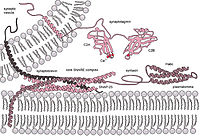
Photo from wikipedia
The central channel of the nuclear pore complex (NPC) is occupied by non-structured polypeptides with a high content of Phe-Gly (FG) motifs. This protein-rich environment functions as an entropic barrier… Click to show full abstract
The central channel of the nuclear pore complex (NPC) is occupied by non-structured polypeptides with a high content of Phe-Gly (FG) motifs. This protein-rich environment functions as an entropic barrier that prevents the passage of molecules, as well as the binding sites for karyopherins, to regulate macromolecular traffic between the nucleoplasm and the cytoplasm. In this study, we expressed individual Nups fused with a crowding-sensitive probe (GimRET) to determine the spatial distribution of protein-rich domains within the central channel in vivo, and characterize the properties of the entropic barrier. Analyses of the probe signal revealed that the central channel contains two protein-rich domains at both the nucleoplasmic and cytoplasmic peripheries, and a less-crowded central cavity. Karyopherins and other soluble proteins are not the constituents of the protein-rich domains. The time-lapse observation of the post-mitotic reassembly process also revealed how individual protein-rich domains are constructed by a sequential assembly of nucleoporins.
Journal Title: Scientific Reports
Year Published: 2017
Link to full text (if available)
Share on Social Media: Sign Up to like & get
recommendations!